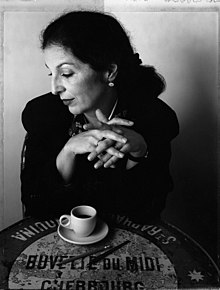|
Louise Fili
Louise Fili (born April 12, 1951) is an American graphic designer known for her use of typography. Her work incorporates elements of modernism and European Art Deco, combining historical typography with contemporary design approaches. Fili designed nearly 2,000 book jackets while working at Random House. Since establishing her own design studio, she has shifted her focus towards restaurant identity, food-related logos, and packaging. She currently teaches at the School of Visual Arts. She has previously taught at The New School, New York University, and Cooper Union.[1] Early lifeFili was born on April 12, 1951, in Orange, New Jersey to Italian immigrants, both schoolteachers. Fili has said that she was “interested in design before [she] even knew what it was”[2] and as a child, carved letterforms into her walls, designed book covers, and created illuminated manuscripts of Bob Dylan lyrics.[1][2] When she was 16, Fili taught herself calligraphy using a Speedball guide and an Osmiroid pen.[3] EducationFili attended Skidmore College in Saratoga Springs, New York to study studio art.[4] In 1973, she received a Bachelor of Science in studio art from Skidmore College. Her senior project was an Italian hand-lettered cookbook.[3] Fili moved to New York City in 1973, interning at the Museum of Modern Art and finishing the last semester of her degree at the School of Visual Arts.[4] CareerAfter graduating, Fili began her career as a freelance designer on special project books at Alfred A. Knopf from 1975-76.[1] At 25, she was hired as a senior designer for Herb Lubalin, where she remained from 1976–78. She found type to be an expressive tool, which set the foundation for her later work.[4] In 1978, she joined Random House as the art director at Pantheon Books, where she rejected standard fonts in favor of creating typographic treatments for each book jacket. Her approach extended to the physical surface treatment as well; Fili rejected the standard shiny finishes and foil-stamping on book jackets in favor of matte, laminated coatings which proved softer and more durable.[5] "I was on a mission to prove that you didn’t have to shout to capture someone’s attention. The cover that I did for The Lover, by Marguerite Duras, was probably the best example of that."[6] The success of her jacket for Marguerite Duras's bestseller, The Lover, in 1984 allowed her increased creative freedom at Pantheon.[3] Fili designed close to 2000 books during her tenure at the publisher.[4] In 1989, she opened her own studio, Louise Fili Ltd, specializing in the design of restaurant identity, food-related logos, and packaging.[3] She sought to "change the accepted formulas of food packaging" by pursuing designs that were quiet and subtle, believing that "one does not have to shout to be noticed."[7] During that time, there were few female-run companies. She knew naming the company after herself could be a liability. Speaking of the experience in a later interview, Fili said she wanted to send out a clear message with her studio name: "If you have a problem with my being female, then I don’t want you as a client.”[4] She has designed for many New York City eateries such as Pearl Oyster Bar, Picholine, Artisanal, The Mermaid Inn, and Via Carota, and has created packaging for Sarabeth's jam, Tate's cookies, and Bella Cucina.[8] Her geometric, often Cubist-like designs show an affinity to European Modernism, particularly the work of Lucian Bernhard, A.M. Cassandre, Jean Carlu, and Italian posters of the 1930s. In 2000, she received three James Beard Award nominations,[9] and since 1998, she has been an elected member of the Alliance Graphique Internationale.[10] In 2004, Fili was inducted into the Art Directors Club Hall of Fame.[1] In 2015, she received the medal of lifetime achievement from the Type Directors Club.[11] In 2009, she redesigned the Good Housekeeping Seal of Approval for its 100th anniversary. In 2014, Princeton Architectural Press published Grafica della Strada, a compilation of her Italian sign photographs. This was followed in 2015 by Graphique de la Rue: The Signs of Paris. Fili has authored and co-authored over twenty books, many of them with her husband, the design historian Steven Heller. A monograph of her work, Elegantissima, was published in 2012. In 2021, she was recognized for her contributions to typography with the Frederic W. Goudy Award, one of the highest honors in the field of typography.[12] Books authored and co-authored
Typefaces
Honors
Permanent collectionsFili's work is held in the following permanent collections:
References
Further reading
External links |
||||||||||||||||||||
Portal di Ensiklopedia Dunia
